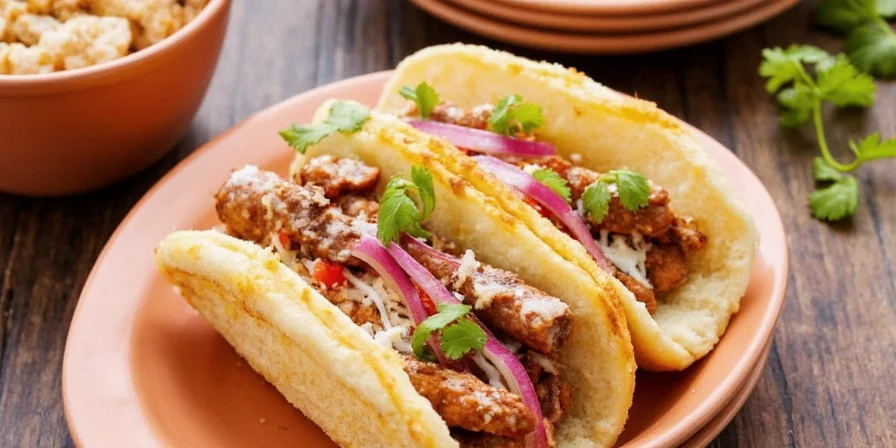The Secret Behind Greek Gyros: Spice Mix Secrets Revealed!
So you've bitten into a warm, meaty, and oh-so-savory gyro, right? That explosion of flavor — smoky, herby, garlicky, and just a little bit tangy — isn't magic. It's science… or at least it is when you know the secrets of the perfect Greek gyros spice mix. Whether you're a home cook with dreams of Mediterranean street food glory or a pro chef aiming to nail authenticity, this guide will take your gyro game from "eh" to "Ela! (That means ‘come on’ in Greek... but also, more importantly, 'YES!')"
Table of Contents
- What Is a Gyro Anyway?
- The Essential Ingredients of the Gyros Spice Mix
- Why This Blend Works So Well
- Pro Tips for Using Your Homemade Gyros Spice Mix
- Variations Across Greece (Yes, It’s Not One-Size-Fits-All)
- Spice Comparison Table
- Conclusion
What Is a Gyro Anyway?
If you’ve ever mistaken a gyro for a shawarma or döner kebab, no judgment — they’re all cousins in the world of rotating meat towers. But the Greek gyro has its own personality.

Photo: A classic Greek gyro — simple, but full of flavor thanks to that spice mix!
A traditional Greek gyro is made with meat — usually pork, though chicken and lamb are common substitutes — marinated in a specific blend of spices, then roasted vertically on a spit. The outer layer is shaved off as it cooks, creating that juicy, aromatic bite we all love. And while the meat itself matters, it's the spice mix that turns a pile of meat into a symphony of flavor.
The Essential Ingredients of the Gyros Spice Mix
The beauty of the gyros spice mix lies in its simplicity. Here’s what goes into a classic version:
- Paprika – Adds color and subtle sweetness
- Dried oregano – Earthy, aromatic backbone
- Garlic powder – Umami-rich kick
- Onion powder – Sweet depth without raw bite
- Salt – Enhances everything
- Black pepper – Sharp finish
- Dried thyme – Herby lift
- Cumin – Warmth and complexity
- Dill (optional) – Brightens the whole mix
Why This Blend Works So Well
Let’s break down why each ingredient plays a role in making this one of the most craveable spice mixes in the world:
| Spice | Flavor Contribution | Chemical Magic |
|---|---|---|
| Paprika | Smoky/sweet base note | Lycopene & Capsanthin |
| Oregano | Earthy, herbal aroma | Carvacrol (antioxidant!) |
| Garlic Powder | Umami boost | Allicin (immune booster!) |
| Thyme | Fragrant, floral note | Thymol (antiseptic properties!) |
| Cumin | Deep, nutty warmth | Apiol (adds bitterness + balance) |

Photo: The holy grail of spice jars ready for mixing up some gyro magic.
Pro Tips for Using Your Homemade Gyros Spice Mix
You got the spices, now let’s get cooking like a pro:
- Use oil to bloom the spices: Mix the dry spice with a splash of olive oil before applying to the meat. This releases volatile oils and enhances flavor penetration.
- Rub generously: Don’t be shy. Use about 1 tablespoon per pound of meat. Massage it in well.
- Marinate overnight: For best results, give the meat 8–12 hours to soak in those flavors.
- Add acidity: A splash of lemon juice or vinegar can help tenderize the meat and brighten the flavor profile.
- Grill for extra char: If roasting on a vertical spit isn’t an option, grill slices of marinated meat for that same caramelized effect.

Photo: Meat marinated in the homemade gyro spice mix — ready to impress.
Variations Across Greece (Yes, It’s Not One-Size-Fits-All)
While the core ingredients remain consistent, regional variations across Greece mean that no two gyro spice blends are exactly alike:
- Athens-style: More garlic-forward, less cumin. Focused on clean herb flavors.
- Thessaloniki-style: Uses more paprika for a deeper red color, and sometimes adds chili flakes for heat.
- Island versions: Some islands use fresh herbs like mint or parsley in addition to dried ones.
- Modern twists: Urban Greek restaurants often experiment with smoked paprika or even a touch of cinnamon for warmth and complexity.

Photo: Regional spice variations across Greece — who knew gyro seasonings could be so diverse?
Spice Comparison Table: Classic vs. Modern Twists
| Spice | Classic Mix | Modern Twist | Regional Variant |
|---|---|---|---|
| Paprika | 1 tbsp | 1.5 tbsp (smoked preferred) | 2 tbsp (Thessaloniki-style) |
| Oregano | 1 tbsp | 1 tbsp | 1.5 tbsp (Crete variant) |
| Garlic Powder | 1 tsp | 1 tsp | 2 tsp (Athens-style) |
| Cumin | ½ tsp | ¾ tsp | ¼ tsp (Athens minimalism) |
| Dill | Optional | Optional | 1 tsp (Corfu coastal twist) |
| Chili Flakes | None | ½ tsp | 1 tsp (Macedonia heat lovers) |
Conclusion: From Marination to Masterpiece
At the heart of every great gyro is the unsung hero: the Greek gyros spice mix. It may seem simple, but it’s a carefully balanced orchestra of aromatics, umami, and earthy warmth. With just a few pantry staples and a bit of care, you can recreate this legendary blend at home and bring a taste of Greece to your kitchen.

Photo: A homemade gyro masterpiece — made possible by your new spice mix skills!
Whether you're grilling meats for a summer barbecue or meal-prepping for the week, having this spice mix in your repertoire will make every bite feel like a vacation. So go ahead — mix, marinate, and marvel at how something so small can create such big flavor.
Now if only someone would invent a spice mix for instant happiness… Oh wait — maybe we just did.











 浙公网安备
33010002000092号
浙公网安备
33010002000092号 浙B2-20120091-4
浙B2-20120091-4